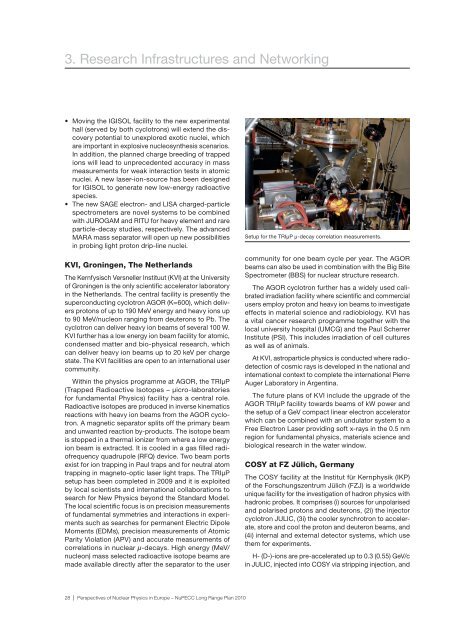Perspectives of Nuclear Physics in Europe - European Science ...
Perspectives of Nuclear Physics in Europe - European Science ...
Perspectives of Nuclear Physics in Europe - European Science ...
Create successful ePaper yourself
Turn your PDF publications into a flip-book with our unique Google optimized e-Paper software.
3. Research Infrastructures and Network<strong>in</strong>g<br />
• Mov<strong>in</strong>g the IGISOL facility to the new experimental<br />
hall (served by both cyclotrons) will extend the discovery<br />
potential to unexplored exotic nuclei, which<br />
are important <strong>in</strong> explosive nucleosynthesis scenarios.<br />
In addition, the planned charge breed<strong>in</strong>g <strong>of</strong> trapped<br />
ions will lead to unprecedented accuracy <strong>in</strong> mass<br />
measurements for weak <strong>in</strong>teraction tests <strong>in</strong> atomic<br />
nuclei. A new laser-ion-source has been designed<br />
for IGISOL to generate new low-energy radioactive<br />
species.<br />
• The new SAGE electron- and LISA charged-particle<br />
spectrometers are novel systems to be comb<strong>in</strong>ed<br />
with JUROGAM and RITU for heavy element and rare<br />
particle-decay studies, respectively. The advanced<br />
MARA mass separator will open up new possibilities<br />
<strong>in</strong> prob<strong>in</strong>g light proton drip-l<strong>in</strong>e nuclei.<br />
KVI, Gron<strong>in</strong>gen, The Netherlands<br />
The Kernfysisch Versneller Instituut (KVI) at the University<br />
<strong>of</strong> Gron<strong>in</strong>gen is the only scientific accelerator laboratory<br />
<strong>in</strong> the Netherlands. The central facility is presently the<br />
superconduct<strong>in</strong>g cyclotron AGOR (K=600), which delivers<br />
protons <strong>of</strong> up to 190 MeV energy and heavy ions up<br />
to 90 MeV/nucleon rang<strong>in</strong>g from deuterons to Pb. The<br />
cyclotron can deliver heavy ion beams <strong>of</strong> several 100 W.<br />
KVI further has a low energy ion beam facility for atomic,<br />
condensed matter and bio-physical research, which<br />
can deliver heavy ion beams up to 20 keV per charge<br />
state. The KVI facilities are open to an <strong>in</strong>ternational user<br />
community.<br />
With<strong>in</strong> the physics programme at AGOR, the TRIµP<br />
(Trapped Radioactive Isotopes – µicro-laboratories<br />
for fundamental <strong>Physics</strong>) facility has a central role.<br />
Radioactive isotopes are produced <strong>in</strong> <strong>in</strong>verse k<strong>in</strong>ematics<br />
reactions with heavy ion beams from the AGOR cyclotron.<br />
A magnetic separator splits <strong>of</strong>f the primary beam<br />
and unwanted reaction by-products. The isotope beam<br />
is stopped <strong>in</strong> a thermal ionizer from where a low energy<br />
ion beam is extracted. It is cooled <strong>in</strong> a gas filled radi<strong>of</strong>requency<br />
quadrupole (RFQ) device. Two beam ports<br />
exist for ion trapp<strong>in</strong>g <strong>in</strong> Paul traps and for neutral atom<br />
trapp<strong>in</strong>g <strong>in</strong> magneto-optic laser light traps. The TRIµP<br />
setup has been completed <strong>in</strong> 2009 and it is exploited<br />
by local scientists and <strong>in</strong>ternational collaborations to<br />
search for New <strong>Physics</strong> beyond the Standard Model.<br />
The local scientific focus is on precision measurements<br />
<strong>of</strong> fundamental symmetries and <strong>in</strong>teractions <strong>in</strong> experiments<br />
such as searches for permanent Electric Dipole<br />
Moments (EDMs), precision measurements <strong>of</strong> Atomic<br />
Parity Violation (APV) and accurate measurements <strong>of</strong><br />
correlations <strong>in</strong> nuclear µ-decays. High energy (MeV/<br />
nucleon) mass selected radioactive isotope beams are<br />
made available directly after the separator to the user<br />
Setup for the TRIµP µ-decay correlation measurements.<br />
community for one beam cycle per year. The AGOR<br />
beams can also be used <strong>in</strong> comb<strong>in</strong>ation with the Big Bite<br />
Spectrometer (BBS) for nuclear structure research.<br />
The AGOR cyclotron further has a widely used calibrated<br />
irradiation facility where scientific and commercial<br />
users employ proton and heavy ion beams to <strong>in</strong>vestigate<br />
effects <strong>in</strong> material science and radiobiology. KVI has<br />
a vital cancer research programme together with the<br />
local university hospital (UMCG) and the Paul Scherrer<br />
Institute (PSI). This <strong>in</strong>cludes irradiation <strong>of</strong> cell cultures<br />
as well as <strong>of</strong> animals.<br />
At KVI, astroparticle physics is conducted where radiodetection<br />
<strong>of</strong> cosmic rays is developed <strong>in</strong> the national and<br />
<strong>in</strong>ternational context to complete the <strong>in</strong>ternational Pierre<br />
Auger Laboratory <strong>in</strong> Argent<strong>in</strong>a.<br />
The future plans <strong>of</strong> KVI <strong>in</strong>clude the upgrade <strong>of</strong> the<br />
AGOR TRIµP facility towards beams <strong>of</strong> kW power and<br />
the setup <strong>of</strong> a GeV compact l<strong>in</strong>ear electron accelerator<br />
which can be comb<strong>in</strong>ed with an undulator system to a<br />
Free Electron Laser provid<strong>in</strong>g s<strong>of</strong>t x-rays <strong>in</strong> the 0.5 nm<br />
region for fundamental physics, materials science and<br />
biological research <strong>in</strong> the water w<strong>in</strong>dow.<br />
COSY at FZ Jülich, Germany<br />
The COSY facility at the Institut für Kernphysik (IKP)<br />
<strong>of</strong> the Forschungszentrum Jülich (FZJ) is a worldwide<br />
unique facility for the <strong>in</strong>vestigation <strong>of</strong> hadron physics with<br />
hadronic probes. It comprises (i) sources for unpolarised<br />
and polarised protons and deuterons, (2i) the <strong>in</strong>jector<br />
cyclotron JULIC, (3i) the cooler synchrotron to accelerate,<br />
store and cool the proton and deuteron beams, and<br />
(4i) <strong>in</strong>ternal and external detector systems, which use<br />
them for experiments.<br />
H- (D-)-ions are pre-accelerated up to 0.3 (0.55) GeV/c<br />
<strong>in</strong> JULIC, <strong>in</strong>jected <strong>in</strong>to COSY via stripp<strong>in</strong>g <strong>in</strong>jection, and<br />
28 | <strong>Perspectives</strong> <strong>of</strong> <strong>Nuclear</strong> <strong>Physics</strong> <strong>in</strong> <strong>Europe</strong> – NuPECC Long Range Plan 2010
















